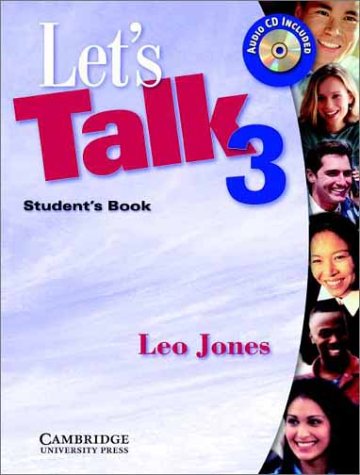
2002 Heralds New Edition of Leo Jones Classic
Cambridge University Press releases "Let's Talk"
Let's Talk 1 (ISBN 0-521-77695-3)
Cambridge University Press kindly supplied
the three textbooks--Let's Talk 1, 2 & 3--each
including its own self-study CD in the book
jacket, and an audiotape sampler for the purposes
of this ESL MiniConference materials review.
English language learning is an intensely
competitive enterprise today, and materials
which don't really attract the learner's interest
make ESL teaching more of a chore than a
pleasure. "Let's Talk" uses modern-day
layout, design and graphics to engage
learners (and teachers) immediately. There
are many, many good quality photographs
throughout the books and, whether the
graphic is a photo or a cartoon, there is
a coherent relationship among all elements
on every spread: the headlines, the captions,
the text-boxes, the exercises.
Each book is divided into 16 units, based
on communicative themes. Each unit is
divided into a two-page "A" spread on
a general theme, such as describing
people ("What do They Look Like?," Book 1,
Unit 2A), and a two-page "B" spread which
delves more deeply into the theme, for
example, talking about personalities ("Your
Personality," Book 1, Unit 2B).
Every unit incorporates listening exercises
based on realistic conversations, with a
great deal of variety to maintain student
interest. Learners are encouraged to make
their own guesses--filling blanks in a
text, listing items in category columns,
for example--before listening to the tapes.
There are good pair and small-group
activities, and they are introduced when
students have been exposed to enough
vocabulary and language functions to
be able to participate confidently.
One of my favorite activities in Book 1
is Activity 3 in Unit 10A ("Can You
Remember?"). Activity 3 is a listening
exercise, based on four cartoons in
which people's childhood memories
are evoked by a particular sight, sound,
smell or touch sensation. Then, students
in pairs compare notes and tell whether
they have similar memories to those
of the individuals on the tape: enjoying
a certain kind of food, taking medicine,
buying a new coat or walking on the beach.
The "Join another pair" activity asks students
to choose several typical childhood memories
from a list, including "the time you learned to
ride a bicycle," "a time you had fun with your
best friend," "a time you went to the mountains
or ocean," "a time you got a special present," "a
time you cried really hard" or "your first day
of school." One can imagine students momentarily
forgetting they are learning a new language, in
the midst of such a strong context for remembering
and speaking in English about important memories
from their pasts.
Another neat feature of the "Let's Talk" series
is the inclusion of "Communication Tasks," which
go deeper than the pair work. In the communication
tasks, each student in a group of three refers to a
different set of instructions on different pages in
the communication task appendix. For example,
in Unit 2B ("Getting Personal") in Book 2, the
communication task entails one student looking
for people in the room who live in an apartment,
have a pet, etc..., while another looks for anyone
who has an older sister, likes to cook, etc..., and
the third member of the group checks to see if
there are classmates who have part-time jobs,
have younger brothers, play musical instruments,
etc... At the end, the three of them get back together
and share the what they've found out about the
other students in the room.
After every set of four units in each book, there
is a two-page spread of "review puzzles," mostly
crosswords and word-search games which focus
on the vocabulary learned. In addition, students
are able to review each unit by doing exercises
from a "self-study" section in the back of the
book, while listening to the CD that is included
with each book. These self-study exercises are
statement recognition, fill-in-the-blank, T/F and
others. Each book also has a grammar appendix, with
very clear examples of the different structures
the student has encountered.
Leo Jones has produced a logically-sequenced,
graphically rich, visually inviting and linguistically
appropriate set of materials. Each book in the series
supplies 40 to 60 hours of instruction. "Let's Talk"
has set a new standard for ESL/EFL materials.
Students (and teachers) are going to have much
less patience with the typical fare of the past
decade or so. Thanks to Jones, perhaps we can
look forward to similarly imaginative, inspiring
and engaging projects from more authors in the
years to come.
Story by Robb Scott
Let's Talk 2 (ISBN 0-521-75074-1)
Let's Talk 3 (ISBN 0-521-77692-9)
 The name Leo Jones is synonymous with
practical ESL conversation activities, thanks
to his many contributions to the field. The
revised 2002 edition of "Let's Talk," a three-book
series for high-beginning to high-intermediate
ESL students, will further establish Jones as
an author of effective ESL materials.
The name Leo Jones is synonymous with
practical ESL conversation activities, thanks
to his many contributions to the field. The
revised 2002 edition of "Let's Talk," a three-book
series for high-beginning to high-intermediate
ESL students, will further establish Jones as
an author of effective ESL materials.